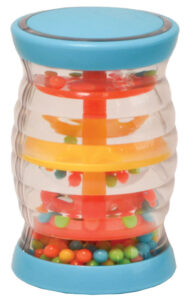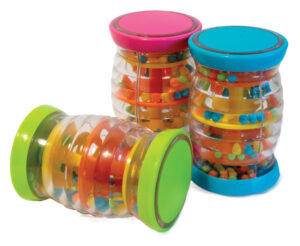Fine motor development
A toddler shakes a sound-making object, with guided practice in starting and stopping shaking movements.



 Sit facing one toddler who is holding his/her shaker. Encourage the toddler to move the shaker and listen to the beads move inside. Move your shaker in ways consistent with the toddler’s movement of his/her shaker. Explain: “We make sound when we move the shakers. We can hear the sound.” Point to your ear when you mention hearing the shakers’ sounds.
Sit facing one toddler who is holding his/her shaker. Encourage the toddler to move the shaker and listen to the beads move inside. Move your shaker in ways consistent with the toddler’s movement of his/her shaker. Explain: “We make sound when we move the shakers. We can hear the sound.” Point to your ear when you mention hearing the shakers’ sounds.
Next hold your shaker still with both hands. Encourage the toddler to make his/her shaker stop. In a soft voice explain: “Our shakers make no sound when we make them stop.”
Depending on the toddler’s reactions to the activity, repeat the shake-and-stop sequence or stand up for a lively shake-and-stop game. Whether you continue to sit or stand, move your body as you move the shaker. Stop moving and hold your position. Encourage the toddler to imitate your stop. Talk with the toddler about actions with the shakers, especially making a sound and stopping the sound.
The activity provides a listening experience driven by actions with a shaker. Making the shaker move and stop moving are important parts of the activity. Some toddlers may be interested in watching the beads. Emphasize that the toddler’s hand is making the shaker move and the beads move. The beads make the sound. Other toddlers may enjoy shaking without regard to what’s inside the shaker or the sound it makes. See the Extra Support tip for how to respond to a toddler’s continued shaking of a shaker.
The sound of some shakers may be annoying to some toddlers. If a toddler reacts adversely to the shaker, try other items that create a less harsh sound. Example: Make a softer sound using a ping-pong ball in a one-quart container. Some toddlers may enjoy the sound of dry sand shaking in a small container.
Extra support
Enrichment
Fine motor development
Toddlers move shakers during a song, including opportunities to stop movement of the shaker when the song ends.



 Invite toddlers to join you in an open space. Give each toddler a shaker. Invite toddlers to sit or stand. Encourage toddlers to start shaking their shakers when the recorded song is playing and stop shaking their shakers when the song stops. Emphasize that our hands are moving our shakers. Demonstrate shaking and especially stopping shaking. Put your shaker in your lap or hold it in both hands when you stop the shaking. Example: “Make the shaker hide on your lap. Cover it with your hands.” It will be helpful for toddlers to see your shaker move and stop. Sing or play the first verse of the song “Shake My Sillies Out.” Repeat if toddlers are interested.
Invite toddlers to join you in an open space. Give each toddler a shaker. Invite toddlers to sit or stand. Encourage toddlers to start shaking their shakers when the recorded song is playing and stop shaking their shakers when the song stops. Emphasize that our hands are moving our shakers. Demonstrate shaking and especially stopping shaking. Put your shaker in your lap or hold it in both hands when you stop the shaking. Example: “Make the shaker hide on your lap. Cover it with your hands.” It will be helpful for toddlers to see your shaker move and stop. Sing or play the first verse of the song “Shake My Sillies Out.” Repeat if toddlers are interested.
Some toddlers are likely to watch their peers more than you during the activity. For this reason, it is important to demonstrate how to stop moving our shakers before the song begins. Still, some toddlers may continue to shake their shakers after the song ends. View this as a signal that a toddler is not ready to engage in shake-and-stop actions at this time without additional support, and positively acknowledge the toddler’s efforts. Example: “You really like to shake your shaker! Now we are stopping our shakers. We can shake them again soon!” Refrain from taking or controlling the toddler’s shaker.
Extra support
Enrichment
Fine motor development
Toddlers start and stop shaking a shaker while listening to different songs.

Shakers—1 per toddler and caregiver


Be Prepared: Determine a simple, familiar song you can sing the first time toddlers are invited to shake their shakers to a song in this activity.
[Sit on the floor with several toddlers.]
Today we will make sounds with shakers.
[Display and describe a shaker. Demonstrate how to make a sound with the shaker.]
[Give each toddler a shaker. If appropriate, acknowledge patience in waiting to receive a shaker.
Lead children in shaking the shakers. It is not expected that toddlers will follow a uniform pattern in shaking.
Prominently hold your shaker to indicate you have stopped shaking your shaker. Ask toddlers to stop shaking their shakers.]
We made a nice sound together by shaking our shakers. We used our hands to shake our shakers.
We can stop our shakers from making a sound.
Stop means the shaker does not move. Our shakers are quiet. We are not moving our hand.
Let’s start shaking our shakers again. This time, I will sing a song while we move our shakers. Please stop shaking your shakers when I stop singing the song.
[Sing a familiar song and lead toddlers in making a sound with their shakers.
When you stop singing, hold your shaker prominently in front of you. Ask toddlers to stop shaking their shakers.]
We made another nice sound together by shaking our shakers. We are learning how to stop shaking our shakers.
Let’s put our shakers on the floor.
Please look inside your shaker. There are little beads in the shaker. The beads are not moving. The shaker is quiet when the beads are not moving.
Would you like to hear a new song?
I will sing a song that tells us to shake, shake, and then stop. Let’s listen to the song.
[Sing the following song. Move your shaker each time you sing “shake” and hold your shaker prominently in front of you when you say “stop.”]
Shake and Stop!
[Tune: “ABCD”]
Shake, shake, shake, shake,
Shake, shake, shake.
Shake your shaker.
Shake and stop!
[Describe how you stopped shaking the shaker when the song said “stop.”]
I will sing the song again. This time, please shake your shaker with me. We can make a nice sound together!
[Sing the song while leading toddlers in moving their shakers. Again, hold your shaker in front of you when you say “stop.”]
We are learning to start shaking our shakers and then make them stop. Let’s try it again. I will sing our song again. We can say “stop” together when it is time to stop shaking our shakers. Remember to listen to the song so we know when to say “stop.”
[Point to your ear. Guide shaker sounds to start and stop as you sing the song. When it is time to stop, encourage toddlers to say “stop” together as they stop shaking their shakers. Repeat the song if toddlers want to continue.]
We made sounds with our shakers. We are learning how to use our hand to shake and stop shaking our shakers.
This activity is more challenging than Option 2 because two different songs are offered and toddlers are invited to say “stop” as part of the second (“Shake and Stop!”) song. Monitor carefully the ability of toddlers to stop shaking their shakers upon request. If this is too challenging for some (or all) toddlers, shift to a song that does not request toddlers to stop shaking their shakers. See Extra Support tips. The activity plan’s provision for looking at the beads when the shaker is “quiet” may be worthwhile to pursue as a follow-up activity with interested toddlers.
At this age, toddlers are not expected to sing along with you or shake their shakers in a uniform pattern. Recognize singing but do not imply it is expected of everyone. Remember that children will benefit from seeing and hearing you sing rather than listening to a CD, and that you can adjust the song in response to toddlers’ actions when you sing.
Extra support
Enrichment
 Materials Needed: basket of shakers, other sound-making toys
Materials Needed: basket of shakers, other sound-making toys
Provide a basket of shakers on a low table so toddlers may continue exploration of how to manipulate a shaker and look at the beads. Sing the song offered in the main activity if toddlers seem interested. On another day, use other sound-making toys to experiment and practice making sounds with an object.
Materials Needed: basket of shakers
Option 3 can be presented to a mixed-age group. Begin the gathering with a song the children will enjoy with the shakers, such as “This Old Man” or “Farmer in the Dell.” Encourage children to shake shakers all through the song. Include the shake-and-stop activity because toddlers will benefit from hearing the word “stop” and seeing older children hold their shakers still.
Encourage older children to demonstrate how to shake the shakers in different ways. Toddlers may wish to follow along or simply watch. Examples:
Shake your shakers high in the air.
Shake your shakers down on the floor.
Shake your shakers up and down.
Shake your shakers side to side.